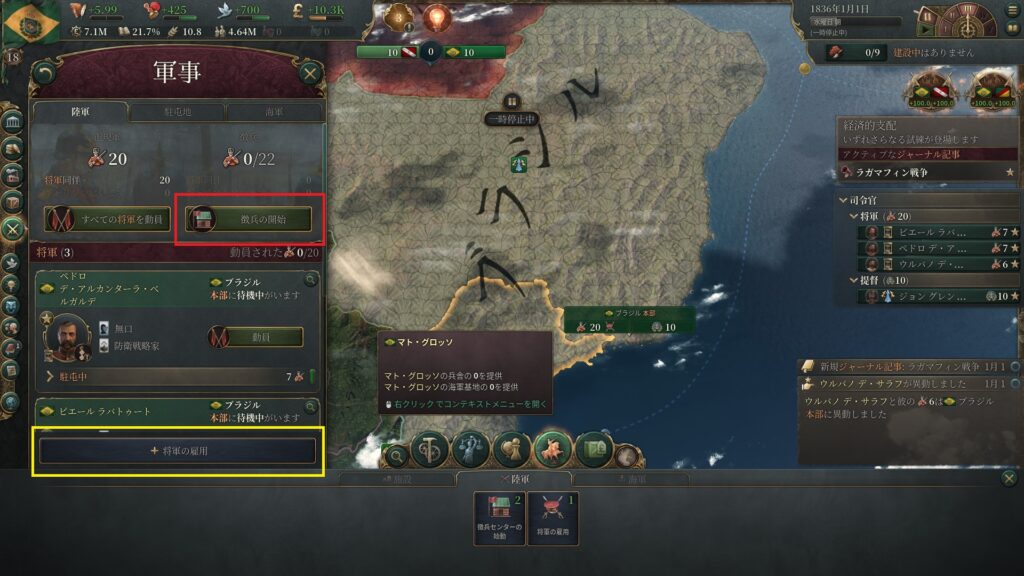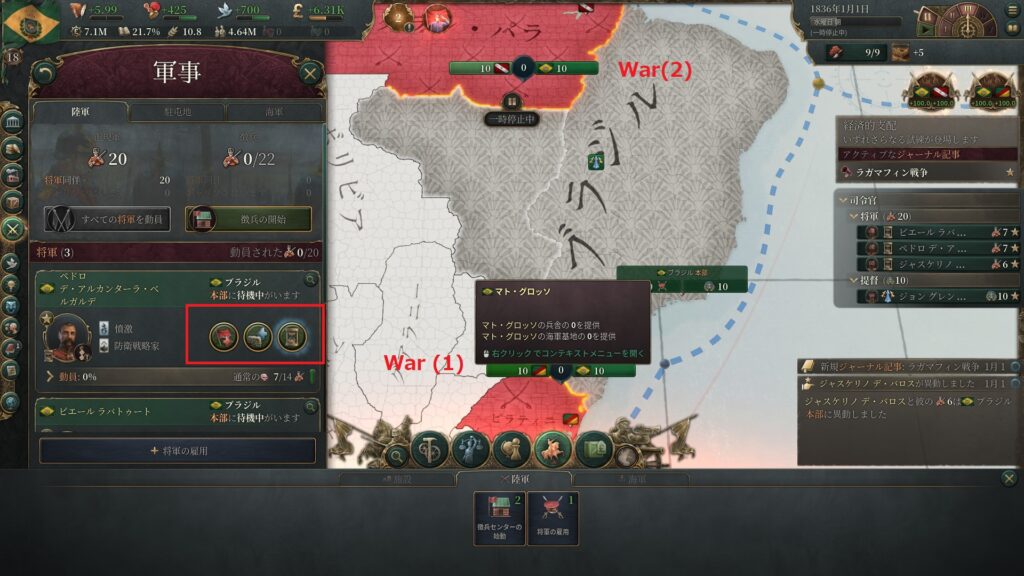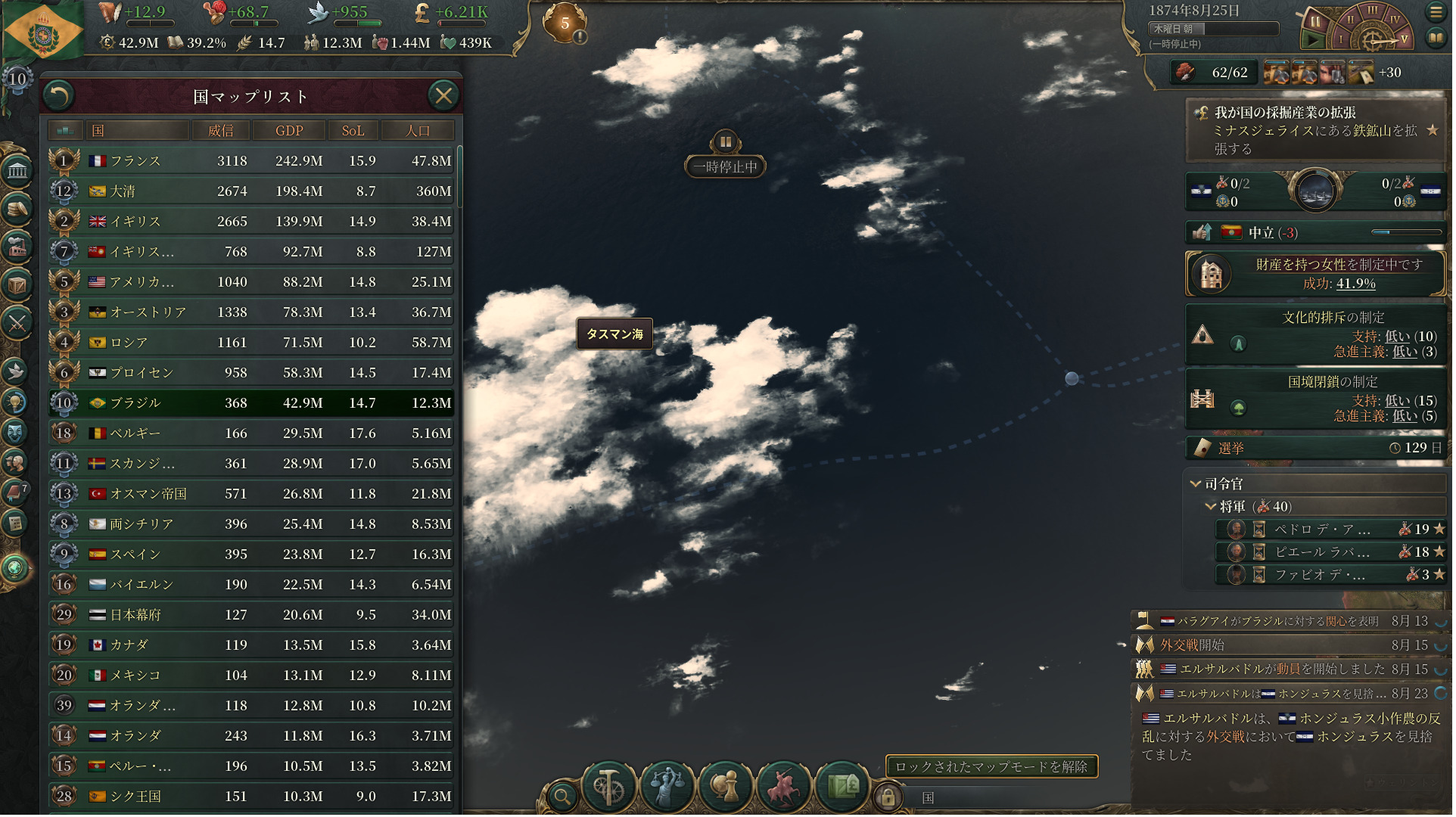Here is a play on Brazil for first-timers to achieve first place in the queue.
Since it has only been on the market for a short time, I don’t know how efficient it is, but I think you can get the basic points for now.
The images are all in Japanese, and the nouns are translated into English, but please use the images to get an idea of what you are looking for.
If you have not played the game yet, or if you have played the game but do not understand it well, please take a look at this page.
The state of Brazil just after the game starts
One of the most important points to keep in mind is that Brazil is at war with two countries right at the start of the game.
Both countries are small in size, but they do not have enough troops on hand, so they need to mobilize their forces to deal with the situation.
Next, in terms of internal politics, the country is still a complete agricultural state and quite poor, but there are states with bonuses for hard materials, which will be in demand from the middle of the game onward.
In addition, the resources are pretty much the way to go after industrialization, since you can get dyes and rubber, which are limited to certain regions.
On the other hand, sulfur, which is used frequently from the beginning, silk, which is used for high-end clothing, and oil, whose demand rises dramatically toward the second half of the year, are not produced in the state.
Of these, sulfur and oil are produced in other countries in South America and are often very small, so it is best to cut them out as the country develops.
Silk, on the other hand, can only be produced in East Asia, but it can be made with the “rayon” manufacturing technology in the middle of the market.
For this reason, if you can unify South America, you will almost never be troubled with resources.
Finally, military wise, with ample resources and a large population for South America, the country will not be in danger of invasion, especially if no major power intervenes.
However, although the population is large, it is not strong enough to start a war out of the blue.
Diplomacy?
It is just a matter of watching out for the powers while trying not to accumulate BAD BOYS.
The powers will be interested from time to time, but they will not intervene too much.
Things to do right after the game starts
Here is a description of the main things to do right after the start of the game.
End the war
Immediately after the start of the game, you start a war with two countries, but there is no regular army fighting against both of them.
(The enemy has a little over 30 armies in total in both.)
Therefore, we need to mobilize civilians to fight and increase our forces.
To do this, first select the military shortcut on the left, then select “Start Recruitment” and select 3-4 states with the most troops you can recruit.
Once you have made your selection, go back to the military screen, this time selecting “Hire Generals” at the bottom to hire one general.
You should now have a total of 3 generals in your pool, so let’s mobilize them all.
(The red box is the draft and the yellow box is the hiring of generals.
When you are done with each, press the button on the right side of the red frame to mobilize the generals!)

When the mobilization is complete, three buttons like the one framed in red will appear in the General’s column.
From left to right, they are: offensive placement, defensive placement, and headquarters placement (standby).
In this case, we want to end the war, so we will place each general on the offensive.
Let’s place one unit in War (1) and two units in War (2) in the screenshot.
At first, you will be at a disadvantage on each front because it takes time to mobilize the drafted soldiers, but this is not a particular problem because the mobilized soldiers will be deployed gradually.

If you leave it in this state, the rest of the war will end on its own in time.
Set up a research
Next, set the research.
In victoria3, it is possible to gradually acquire technologies that have been researched by other countries in the form of knowledge propagation.
Therefore, there is basically no need to force research on old or low-priority technologies.
In addition, since the size of economic power is of considerable importance in victoria3, it is correct to research production-based technologies that will strengthen economic power.
In the case of Brazil, the lack of tools makes “lathe” a good first choice.
Alternatively, “intensive agriculture” is a good option to strengthen the current agriculture.
However, agriculture is not a priority for the future, since it will come later when various factories are built in the future.
Constructing buildings
The initial construction sector is not enough, so 2-3 additional buildings should be built.
It is better to distribute the construction sectors than to build them all in one state, so we will build them in states where there are no construction bureaus yet.
Also, select the red frame in the image and choose the second “steel frame facility” from the top.
Although it is more expensive to build, it is essential because it increases the efficiency of construction.
Once you have done this, go to the market tab and sort the detailed market prices in order from highest to lowest.
These high market prices indicate that there is a shortage in your country, so you will basically build in the order of shortage.
However, please note one point.
At first, be sure to build about 10 iron mines and 2 tool workshops.
After that, build 2 steel workshops and then again 3-4 iron mines.
After that, you will need some coal mines.
These are the stepping stones for “mechanic tools” and future industrialization.
After that, you will need furniture, clothes, food, and other items that are in short supply.
Early Strategies
This section describes developments up to about the 1870s.
Overall Strategy
Brazil is not very populous, in addition to being slow to industrialize.
For this reason, it is necessary to promote industrialization while encouraging an influx of immigrants.
On the other hand, sulfur, which is needed for agriculture and military operations, cannot be obtained domestically, so it must be acquired quickly in some way.
For this reason, industrialization, acquisition of sulfur mines, and immigration policies are important.
Basically, industrialization increases money, and tax reductions and programs are introduced to offset the increased money.
Industrialization Strategy
Due to the inland location of Minas Gerais, where important facilities such as gold mines, iron mines, lead mines, and tool workshops are located, there is an immediate infrastructure shortage, and when there is a shortage, the supply will decrease.
For this reason, we will mainly industrialize the coastal areas until the railroad study is completed and we can afford to build it.
In addition, due to population reasons, we will place necessities such as paper, clothing, furniture, food, and glass, as well as high demand items such as steel workshops, tool workshops, chemical plants, and power plants, mainly around Rio de Janeiro, and will build ammunition workshops, weapons workshops, shipyards, universities, and art universities away from Rio de Janeiro, where there are fewer We will build mainly facilities that are not problematic even if they are few in number.
Basically, we can simply repeat the process of researching production systems->introducing new methods->constructing high-demand resource facilities.
Also, periodically build railroads to avoid infrastructure shortages.
If you have extra money to spend on the immigration policy, which we will explain next, you can build additional construction sectors.
Strategies for acquiring immigrants
Immigrants seem to come preferentially to states with a high standard of living.
Therefore, provide jobs to peasants through industrialization while slightly reducing taxes when surpluses are available.
Also, on the policy side, multiculturalism is very effective, but difficult to introduce in the initial power structure.
Particular obstacles to reform are the early religious powers and landowners.
Therefore, we will gradually reduce their power by introducing a “professional police force,” “private schools,” and a “ban on slavery. The “slave ban” will be gradually introduced.
However, if you proceed all at once, radical forces may emerge and lead to a revolution.
Therefore, after implementing one of these measures, take some time to introduce it gradually.
If multiculturalism is introduced by the 1870s, immigration will be so frequent that construction will not be completed in time.
In addition, various systems such as health care and security can also be introduced more effectively to promote population growth and immigration policy.
Acquisition of sulfur mines
Unfortunately, at present, NPCs are unable to effectively improve resource facilities, making it difficult to acquire sulfur through friendly means.
Therefore, acquisition is basically done through war.
South America or Southeast Asia are recommended as options.
In either option, the Netherlands and France will be troublesome and should be made friends with.
Friendship from the diplomatic tab is OK.
Aim for Venezuela (later to become a good oil producer) and Peru and Bolivia (rich in mineral resources).
Alternatively, invading small countries around Brunei in Southeast Asia is also effective.
In the former case, the South American states are likely to join the war, but if they have the same number of soldiers, they can be crushed, so as long as there is no intervention by a powerful country, you can annex them whenever you see an opportunity.
In the latter case, France and the Dutch East Indies are troublesome.
It is safe to wage war with these countries while maintaining friendly relations with them and taking advantage of their busy schedules.
(In this game, each country can only participate in one war, so if you are fighting with another country, you can fight safely.)
Also, since it is a landing operation, some naval power is required. (If you have around 25 ships, you should be able to get through several landings.)
Screenshots of the actual play
This is the state of affairs as of 1874 if we actually proceeded with the above policy.
Although we are not among the powers, we are already on par with them in terms of GDP.
Also, although the population is still small, the growth rate of POP is more than twice that of the U.S. due to the high standard of living and medical care, so the population growth is more than twice that of the U.S., which is about twice the population difference between the two countries.

This time, we were quite unlucky and Granada and Bolivia became protectorates of the powers.
This is why we are in this situation despite starting at a very bad pace, which we have not been able to do except for the annexation of Ecuador.
If things had gone smoothly, I think we would have been able to grow more.
In this case, it would be better to focus on Southeast Asia once again.
The next screenshot shows the population.
The population has already more than doubled compared to when we started.
The part of the population that is growing quadratically in the second half is after the introduction of multiculturalism.

The peasants are no longer able to keep up with the rate of immigration and construction is overflowing.
If we give them jobs, they will grow quickly.
This is the first installment of the project, so this is an introduction to the strategy at the beginning of the project.
I will introduce the strategies from the middle stage until you become a powerhouse in the next article.



